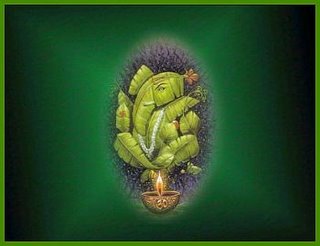This beautiful quote from the writings of the South American writer Paulo Coelho brilliantly explains the working of the process of pilgrimage.
'When you travel, you experience, in a very practical way, the act of rebirth. You confront completely new situations, the day passes more slowly, and on most journeys you don't even understand the language the people speak. So you are like a child just out of the womb. You begin to attach much more importance to the things around you because your survival depends upon them. You begin to be more accessible to others because they may be able to help you in difficult situations. And you accept any small favour from the gods with great delight, as if it were an episode you remember for the rest of your life.
At the same time, since all things are new, you see only the beauty in them, and you feel happy to be alive. That's why a religious pilgrimage has always been one of the most objective ways of achieving insight. The world "peccadillo," which means a "small sin," comes from pecus, which means "defective foot," a foot that is incapable of walking a road. The way to correct the "peccadillo" is always to walk forward, adapting oneself to new situations and receiving in return all of the thousand blessings that life generously offers to those who seek them.'
[Paulo Coelho]
8 January 2007
Pilgrimage
Pongal Festival
India is bestowed with the bliss of festivity. A major segment of the population here depends on agriculture, so as a result, most of the festivals are also related to the agricultural activities of the people. Pongal is a highly anticipated festival celebrated in Tamil Nadu which marks the harvesting of crops by farmers and is the first festival beginning off each New Year in this State.
Pongal, will be held next week between January 13th to 16th (the dates are calculated by the solar calendar so don't change from year to year like festivals calculated by the moon calendar). The Festival is the time when people thank God, Earth and their Cattle for a wonderful harvest and celebrate the occasion with joyous festivities and rituals.
The first day of the festival, known as Bhogi, begins on the last day of the month of Margazi. On Bhogi people clean out their homes collect unwanted goods and in the evening, light bonfires and burn old, used and unwanted items signifying the destruction of memories and associations. The slate is thereby made clean and one is now ready to start the New Year.
The second day of the festival, Surya Pongal, which is the day on which the celebrations actually begin, is the first day of the Tamil month Thai. On this day, Surya, the Sun God is worshipped and women wake early to create elaborate kolam on the grounds in front of their doorway or home.
The lady starts of by sweeping in front of the house, then sprinkles water all over the ground and lays a covering paste of cow dung. Once the dung is dry, she will proceed to make wonderful, intricate, geometric patterns in white power. Previously ladies would use powdered rice; thereby providing a nice tasty treat for the ants. Unfortunately nowadays few people opt for rice and instead use powders in different colours that have all sorts of chemical additives; which instead of feeding the ant would probably finish them off quickly! If you want to enjoy an early mind-boggling experience at Pongal, watch a lady prepare her intricate kolam that morning!
It is also on this day that Chakkara Pongal, a delicacy of harvest rice cooked with jaggery, ghee and cashew nuts is offered to the Sun God.

This is a picture of a previous Pongal, in which ladies are doing a 'communal cook' of their pongal dish. Once the dish is prepared the ladies take it home to eat with their family. But by coming together in this 'communal cook' the ladies maintain a link with the ethos of village cooperation during harvest times.
The third day Maatu Pongal (maatu=cattle) is devoted to paying homage to cattle. Cows and Bulls are decorated with paint and bells and people pray to them. The fourth day, termed Kaanum Pongal, is the one on which people travel to see other family members and friends.
Magnetic Mountain
'There is a magnetic mountain which attracts all living beings. The moment one thinks of it, it controls the actions of all beings who think of it and attracts them towards itself. Not only it attracts to itself but makes them motionless. How wondrous is the power of this magnetic mountain which takes such sacrifices.'
[Arunagiri Yogi Viyayathe]
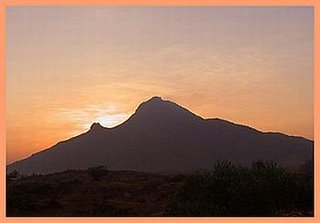
'Arunachala is the most sacred holy place of all. It is the heart of the world. Know it to be the secret and sacred heart-centre of the God Shiva. Meditate then that in the Heart of Arunachala surges the spirit glory, within which is contained all the worlds. I ordain that residence within a circle of thirty miles of this Mountain shall alone suffice to burn off all defects and blend a person with the Supreme Spirit.'
[The Skanda Purana]
Neem Tree
The word Neem is derived from Sanskrit Nimba which means 'bestower of good health'. Neem or Margosa is a botanical cousin of mahogany and belongs to the family Meliaceae. The Latinized name of Neem, 'Azadirachta Indica' is derived from the Persian and literally means 'The Free Tree of India'. The name it goes by in Tamil Nadu is Vembu.
The Neem is a broad-leaved, evergreen tree which can grow up to 30m tall and 2.5m in girth. Its trunk is 30-80 cm in diameter. Its spreading branches form a rounded crown of deep-green leaves and honey-scented flowers as much as 20m across.
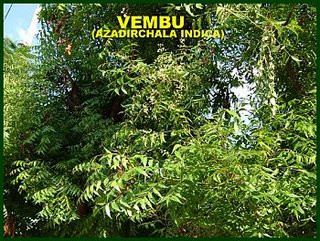
The tree which is known to cure many diseases, is a pest control agent as well as fertilizer. It is an intelligent pest repellent as it does not affect useful species only harmful pests. Furthermore because of its complex molecular structure pests do not become immune to it! The Neem releases more oxygen than other trees and thus is used in many areas to prevent desertification. It's completely safe and causes no harmful side-effects. It has also been used as a health and beauty aid in India for more than 5000 years!
This tree is found in abundant numbers throughout Tiruvannamalai District is the Neem tree holds an important place in Siddha and Ayurvedic medicine preparation. In fact the ancient Vedas called Neem 'sarva roga nivarini', which means 'one that cures all ailments and ills'.
The tree is considered to be of divine origin. According to Indian mythology, amrita (ambrosia or the elixir of immortality) was being carried to heaven and a few drops of it fell on the Neem tree. Another story tells of the time the Sun took refuge in the Neem Tree to escape from the awesome powers of the demons. Planting three or more Neem trees during one's lifetime was considered a surefire ticket to heaven!
Local Projects
A State Minister recently laid the foundation stone for a boat house at Thamarai Kulam Tank in Tiruvannamalai, as part of a Rs.75 Lakh (US$170,000) facelift to the Water Tank.
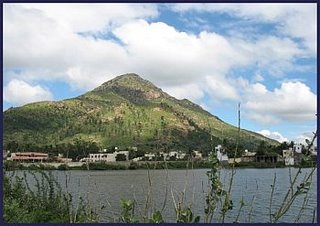
I don't know the history of this particular tank. From what I understand it is not regarded as a sacred tirtham but is connected with the history of rulers and monarchs of the area. In this respect the Tank has two Manadapams (small ceremonial halls)on the tank edge.
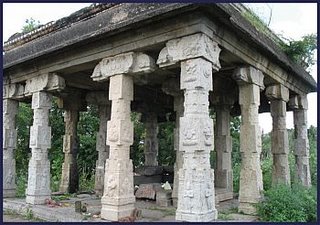
As well as the boat house, work was also inaugurated at Tiruvannamalai Bus Stand in an important renovation project which is estimated will cost Rs.38 Lakh (US$85,000). Both projects are to be implemented under tourism development schemes.
The Tamil Nadu Urban Infrastructure Development Corporation has given its consent for the implementation of 40 other projects which were previously proposed by Tiruvannamalai Municipality. In this respect the Corporation's contribution to the implementation of the projects will be Rs.1.12 (US$251,100) and the cost to the Municipality will come to Rs.12 Lakh (US$27,000).
As well as the above announcements, the Minister called upon the newly elected Municipal officials to raise the status of Tiruvannamalai Municipality and make it the 'cleanest municipality in the Nation'!
3 January 2007
Free Clothes

Government officials have inaugurated the distribution of free dhotis and saris at Polur in Tiruvannamalai district.
Over the next 10 days, 3.28 crore (32,800,000) people across the State will get free dhotis (gents wraparound skirt) and saris ahead of the Pongal Festival which takes place between January 13th to 16th.
Nine Entrances
There are nine entrances to Tiruvannamalai and as the town is approached from any of these roads, Arunachala can be seen from a distance of over 15 miles. Some of the most sublime and inspirational views of the Hill are those that are seen from a distance. Certainly most who come are strangely moved by the Hill's haunting beauty and believe it possesses a grandeur surpassing all other mountain ranges and holy sites.
The famous Paul Brunton, who did much to introduce aspects of Indian spiritual thought to the West and was largely responsible for popularising the saint Ramana Maharshi, wrote:
'I stand at the door and look up at the Hill of the Holy Beacon; Arunachala, the Sacred Red Mountain. It has become the colourful background of all my existence . . . It is somehow inescapable in this place, but the strange spell it throws over me is more inescapable still. I begin to wonder whether this queer, solitary peak has enchanted me.'
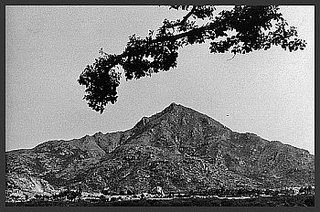
'This lonely hill holds me in a powerful thrall, despite the fact that I have seen others, infinitely more attractive. This rugged piece of nature, with its red laterite boulders tumbled about in disorderly masses and glowing like dull fire in the sunlight, possess a strong personality which emanates a palpable awe creating influence.'
Health Care
Animal Centre
An animal health centre was inaugurated this week at Pazhayanur village in Tiruvannamalai District. The centre was specifically opened in response to the large sheep population in Pazhayanur and its neighbouring villages. Treatment, immunisation, and deworming is to be done at the facility.
****************
Medical camps
As many as 300 medical camps would be organised in Tiruvannamalai District within the next two years under the Varumun Kappom Scheme. The scheme which was recently launched at Thandarampattu Village this week would be part of a network of camps able to serve 5,000 people in rural areas and 50,000 in urban areas.
The Government has committed to provide Rs.500,000/- (US$ 12,000) to each District Headquarter Hospital as annual maintenance cost and Rs.75,000/- (US$1,700/-) to each primary health centre. The upgrade of 75 health sub-centres have also been sanctioned (2 in Tiruvannamalai District) to Primary Health Centres.
The State Varumun Kappom Scheme, would provide such diagnostic equipment as semi-auto analyzers and ultra sonogram at medical health camps. The authorities have been urged to upgrade the quality of treatment at Government hospitals in Tamil Nadu to match those provided in the neighbouring state of Kerala.
Sacred Geometry
Through a combination of various social reasons, over the last centuries, Temples and Shrines throughout India fell into disuse and decay. This certainly occurred at Tiruvannamalai where the situation became so bad that even the Asta Lingams were taken over by squatters and homesteaders.
In 1968 an Arunachala devotee named Moopanar Swami came to Tiruvannamalai who understood the significance of the neglected, dilapidated condition of the Asta Lingams.
 South West, Niruthi Lingam, Growth
South West, Niruthi Lingam, Growth
Ancients originally constructed the Asta Lingams at their 8 cardinal and inter-cardinal points to represent, characterise and vitalise certain aspects and qualities of life, namely:
East, Indra Lingam, Sun
South East, Agni Lingam, Fire
South, Yama Lingam, Death
South West, Niruthi Lingam, Growth
West, Varuna Lingam, Rain
Northwest, Vayu Lingam, Air
North, Kubera Lingam, Wealth
North East, Easanya Lingam, Peace
North, Kubera Lingam, Wealth
Restoration of the actual Asta Lingams is now complete; although development of attached land still continues. Many people believe that the revitalisation of the Lingams is in some way responsible to the sudden revival of interest in Arunachala. It certainly is a fascinating coincidence!
31 December 2006
New Time
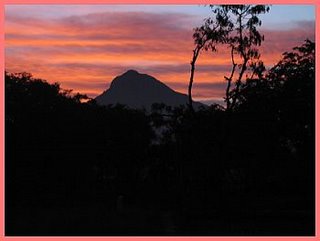
Hesitant light glows, shaded in hues of crimson
Purple strands wrap around rosy fabric
Shining whispers gaining strength with each passing moment
Growing courage and covering the haloed heavens
With a splendid legacy of auspicious hope
Billowed vapors coalesce, gathering to bloom
Fields of mystic blossoms bending low to breezes
Sensitive, each responsive flower turning its face
Into the brilliance of the morning sun
To float away and meet the distant horizon
Feathered friends of angels soar on cushioned air
Singing songs of glorious restoration
Hopeful joy lands delicate, tenderly embracing
Uniting memoirs of yesterday with the promise of today.
[unknown]
Arunachala Ashrams
After Ramana Maharshi's mother Alagammal died on May 19th, 1922, Sri Ramana would often walk from Skandashram to her tomb, which was located on the banks of Pali Tirtham, a tank at the foot of the southern slope of Arunachala. It was at that point in time that Ramana came down permanently from Skandashram to settle at the base of the Hill.
A lot of the land that is now Ramana Ashram was originally part of a burial ground which slowly was acquired by his devotees and then amalgamated into the developing Ashram.

[In the above picture you can see the the Pali Tirtham and the Shrine built around the samadhi of Sri Ramana's Mother, Alagammal]
Coincidentally the spot that Ramana spontaneously selected for the shrine of his deceased Mother, was at a site which is almost directly South of the Hill. One can observe that it is no coincidence that most of the Ashrams and residences of holy personages and saints are located South of Arunachala.
Ancients, who perhaps had a stronger more developed connection with planetary and other worldly influences, believed that the cardinal directions of Arunachala correspond to certain qualities. The South is meant to be the most conducive to a spiritual life, the north to healing, the east to commerce and successful business enterprises and the west to strong earthly energetic influences.
In 1929 what is now Seshadri Ashram started to develop in a location next to Ramanashram. When Sri Seshadri Swamigal died that year in his small room near the main Gopuram of Arunachaleswarar Temple, it was originally planned to cremate his body until devotees intervened who wished to preserve it in the traditional method of entombing a saint in a samadhi shrine.
Thus his body was brought out in procession from his humble room near the Big Temple in town. The procession was said to have been so splendid that the entire stock of camphor in Tiruvannamalai shops was exhausted and all incoming buses were full and over crowded. The streets were jammed with devotees, the air was filled with devotional songs and the music of instrument players. At Agni Tirtham Sri Ramana Maharshi joined the procession and nearby a samadhi was constructed and Sri Swamigal's body interred with devotees purchasing the land bit by bit, much in the same way as Ramana Ashram. The Seshadri tomb is now enshrined within what was developed to become Sri Seshadri Ashram on Chengam Road, Tiruvannamalai.
[Sri Seshadri Swamigal Ashram, with his Samadhi enshrined in a small Temple in the Ashram which has frequent pujas and rites]
Both Ramana Ashram and Seshadri Ashram are popular places for pilgrims to stay and both have functions connected with the samadhis of their respective Saints that attract many visitors other than just those being accommodated at the Ashrams.
[The photograph is of the samadhi hall of Sri Ramana. At the top of the photograph is the Lingam which is directly above the samadhi of Sri Ramana Maharshi].
The Guru

In this day and age when there is a great multiplicity of teachers, methods and choices it is very helpful to read Sri Ramana's remarks regarding the Guru, particularly his remarks about the role of Arunachala as Guru.
Q: What are the marks of real teacher (Sadguru)?
A:Steady abidance in the Self, looking at all with an equal eye unshakeable courage at all times, in all places and circumstances.
Q: There are a number of spiritual teachers teaching various paths. Whom should one take for one's Guru?
A: Choose that one where you find Shanti (peace).
Q: Should we not also consider his teachings?
A: He who instructs an ardent seeker to do this or that is not a true master. The seeker is already afflicted by his activities and wants peace and rest. In other words he wants cessation of his activities. If a teacher tells him to do something to do in addition to or in place of, his other activities, can that be a help to the seeker? Activity is creation. Activity is the destruction of one's inherent happiness. If activity is advocated the advisor is not a master but a killer. In such circumstances either the Creator (Brahma) or the Death (Yama) may be said to have come in guise of a master. Such a person cannot liberate the Aspirant, he can only strengthen his fetters.
Q: How is one to decide upon a proper Guru? What is the swarupa (nature or real form) Guru?
A: He is the real Guru to whom your mind is attuned. If you ask 'How to decide who is the Guru and what is his swarupa?', he should be endowed with tranquility, patience, forgiveness and other virtues; he should be capable of attracting others even with his eyes just as magnet attracts iron; he should have a feeling of equality towards all. He who has these virtues is the true Guru . . .
Q: Maharshi did not have a human guru.
A: I might have had one at one time or other. Did I not sing hymns to Arunachala. What is a Guru? Guru is the God or the Self. First a man prays to God to fulfil his desires. A time comes when he will no more pray for the fulfillment of material desires but for God himself. God then appears to him in some form or other, human or non-human, and to guide him to himself in answer to his prayer and according to his needs.
[Compilation of Ramana Maharshi's talks on the Role of the Guru]
30 December 2006
Tiruvannamalai Facts
The hub of Tiruvannamalai is the Annamalai hill with a height of 2,472 feet, which is regarded as Lord Shiva himself, the path along the hill called the 'girivalam' is a stretch of road 14 kms., which circumambulates the Hill. The Arunachaleswarar Temple is situated on the eastern side of the Hill in an area of approximately 24.32 acres. About 4 kms of the 'girivalam' pathway falls within the limits of the Municipality, while the remaining 11 kms., falls within the control of five different panchayats regional assemblies).
The life of the town's people centres on these deities and structures. The Temple itself, which is situated on 24.32 acres of land, has four main entrances called 'gopurams' built in the 16th century, the highest being 217 feet.
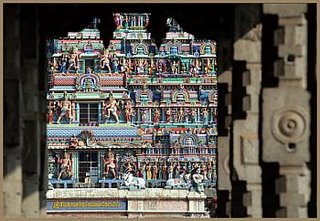
Within the Temple precincts, there are water tanks, an orphanage, cow sheds to look after the Temple cows and Temple elephant and notified areas for collecting used flowers and other offerings made by the devotees.
The Temple is administered, controlled and regulated under the Tamil Nadu Hindu Religious & Charitable Endowments Act, 1959.
Book Store
You can now select and purchase online Vedic Books by visiting the link on the left hand column of this Blog. The Vedic Book section is a comprehensive one and includes a large inventory of International and Domestic spiritual books on such categories as; biographies, architecture, arts, astrology, ayurveda, inspiration, meditation, music, jyothish, tantra, vaastu, vedic culture, novels, philosophy, nature and religion.
Arni Silk
The silk industry of the town of Arni, Tiruvannamalai District, which is famed for its embroidered silk saris and garments business is in the process of building a skilled labour force to tap National and International markets. The Arni silk industry is already getting its saris embroidered in Kanchipuram however there is not enough skilled labour available to even complete existing assignments.
The Textile and Handloom Department in association with three non governmental organisations (South India Trust, RWCDS, and the Tiruvannamalai and Annai Kasthuriba Handicraft Development Association for Rural Women) are conducting a free training programme on embroidery design on silk saris for thirteen ladies of Tiruvannamalai.

After the initial programme, the women will have to undergo further phases of training (under the supervision of technicians from Kanchipuram) in; computerized designing tools and colour combination and marketing. It is hoped that by the end of their training, the qualified ladies will be capable of training subsequent candidates.
Four to six women could simultaneously work on a sari on its embroidery frame bed. The immediate aim is to install at least 10 frame beds, with adequate skilled labour power, in the Temple town. It is believed that silk embroidery will help revitalise the Arni silk industry and at the same time open up new avenues of employment for women.
Driving Licences
Officials recently warned that stern action would be taken against people found possessing fake driving licence reportedly being fraudulently prepared by some computer centres.
Regional Transport Offices have been issuing driving licence in a particular format since 1996 and each Regional Transport Office (with a distinct jurisdiction), has a unique code number, which should be on the driving licence.
Holograms on licences should contain three English letters followed by a four digit number. The symbol of the Tamil Nadu Government is perceptible when the licence is looked at either downward or upward, thereby making it possible to identify original licences provided by the Transport Department.
In my opinion, the crucial matter is not driving licences but peoples' observance of the 'rules of the road'. The death and accident rate in all parts of India is horrific; for the reason that no-one obeys traffic regulations! In some strange way I believe legislators will always be shy of implementing the draconian regulations needed to bring greater road safety, because somehow they feel it would be impinging on letting people 'do their own thing'.

Perhaps the only way the road culture will ever change is if petrol becomes too expensive and people are forced back to bicyles and oxen drawn carts!
26 December 2006
Christmas Day
On Christmas day I decided to do giripradakshina around Arunachala as it had been quite sometime since I last walked around the Hill. I live in the countryside and am surrounded by fields and an agricultural landscape and also have a wonderful view of Arunachala. Because I live in such idyllic surrounds, I usually prefer quiet solititude to the more energetic rounding of Arunachala. But being that it was a such a special Holiday, and the sky was almost violet in its intense blueness, the sun bright and warm and the Holy Hill glistening in its shimmering efflugence; it seemed the perfect time to get re-acquainted with the ritual of giripradakshina.
I took my camera to record some of the sights of the afternoon. Here is a young boy in front of the Anjaneya Temple (Anjaneya is the monkey God famous for being a great devotee of Lord Rama). The lad's mother and father are close by, involved in the same pursuit i.e., the making of Tulsi malas. The aroma of Tulsi is very sweet and when one handles it, it leaves a strong, sweet scent on the skin. As its Christmas, schools are out for a week, so the young lad is helping his family for the day.
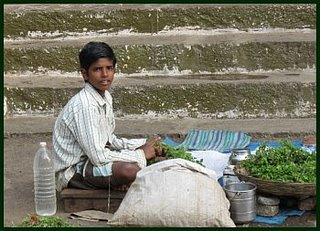
Below is one of the rest-a-while parks that are dotted around the fringe of the pradakshina pathway. Unfortunately the parks nearly always seem to be locked, maybe the park caretakers don't trust us enough to keep the park clean in their absence! A Bonnet Macaque monkey is hanging around in front of the park. At the beginning of my walk I bought a large bag of rusk bread for the monkeys and dogs but ran out of supplies quickly and had to purchase more on the way.
Please do remember if you feed the monkeys to throw the food off the road. Even though it is easier for them to pick up food from the tarred roads, doing so makes the monkeys lose their fear of the street and so leads to accidents. The monkeys are tame and generally very well mannered.

These two kids are visiting Tiruvannamalai for the first time with their Mother. They hail from Chennai and were particularly proud of their nice, new tonsures from the Arunachaleswarar Temple.
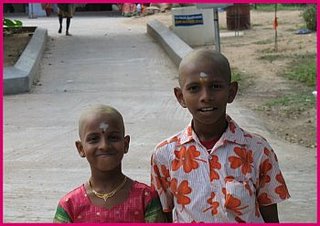
Unfortunately nobody keeps to the recommendations either regarding the use of the horn or speed restriction. Hopefully when the ring road finally gets built heavy traffic will no longer use the giripradakshina pathway.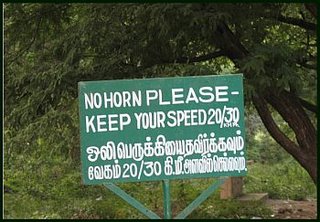
What you see below is becoming increasingly common on the giripradakshina road. About 10 years ago the pathway was unlighted and in a narrow and poor, rutted condition. Even though the intentions were kind hearted, the consequences of widening the road and providing bright lighting, has had unfortunate consequences. Because now pilgrims do not have right-of-way and are consistently pushed to the side of the road by speeding trucks and buses. This situation unfortunately doesn't improve during the evenings and nights because sadly, as the lighting is so excellent, heavy traffic constantly travels on the road.
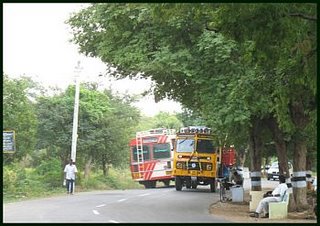
This decorated tree is a new item. In India ladies like to ornament special trees (specially located at shrines or holy spots) with personal items like bangles or auspicious threads in performance of a vow. I think this particular tree has been helped along by some enterprising folk who thereafter take up a nearby perch and sell items such as camphor and small clay plates, so that pilgrims can perform aarti (the waiving of light) to the tree.

Parents love to dress their children up like dollies. This little girl looks adorable with her bangles, flowers and necklace. The Mother, who was standing next to the child as I took the picture, was delighted that her beautiful angel was being admired and photographed.
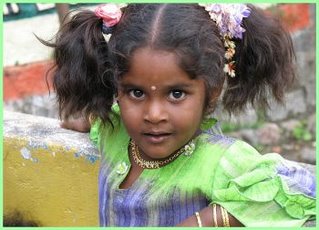
These gents are devotees of the God, Iyyapan. They are on their way to the famous Iyyapan Temple at Sabrimala. The journey to the Iyyapan Temple is almost as important as what happens once the pilgrim arrives. It is traditional that the journey itself is a pilgrimage, and devotees on their way to Sabrimala will stop off at designated shrines, holy places, saints or sadhus to perform different worships. A unique aspect of Sabrimala, is that there is a sex restriction. Gents are allowed, but as to ladies, only girls or older ladies are allowed to visit and ladies of childbearing age are not welcomed.

Just a few snaps to remember my Christmas Day walk around the Hill.
Mooji Satsangs
Now that Mooji's silent Retreat at Arunachala is over, he will be available for satsangs in January 2007 which will be open and free to all. Satsangs will take place daily at 10am January 10th to 14th. Location:
Sri ARUNACHALA IWAY
(near SivaSakti Amma Asramam)
289, ROA Colony, Ramana Nagar, Tiruvannamalai
phone: 0091 (0)4175-238591
Mooji was born Anthony Paul Moo-Young January 29th, 1954 in Port Antonio, Jamaica. In 1969, he moved to the UK and is presently living in Brixton, London. Mooji is a direct disciple of Sri Harilal Poonja, the renowned advaita master, or Papaji, as his followers call him.

"Mooji is a direct disciple of Sri Harilal Poonja, the renowned advaita master, or Papaji, as his followers call him. In 1987, a chance meeting with a Christian mystic was to be a life-changing encounter for Mooji. It brought him, through prayer, into the direct experience of the Divine within. Within a short period, he experienced a radical shift in consciousness so profound that outwardly, he seemed, to many who knew him, to be an entirely different person. As his spiritual consciousness awakened, a deep inner transformation began which unfolded in the form of many miraculous experiences and mystical insights. He felt a strong wind of change blowing through his life which brought with it a deep urge to surrender completely to divine will. Shortly after, he stopped teaching, left his home and began a life of quiet simplicity and surrender to the will of God as it manifested spontaneously within him. A great peace entered his being, and has remained ever since."

Since 1999, Mooji has been sharing satsang in the form of spontaneous encounters, retreats, satsang intensives and one-to-one meetings with the many seekers who visit him, from all parts of the world, in search of the direct experience of truth. Mooji shares satsang in Brixton, London, where he lives. He also travels regularly to Ireland, Wales, Italy and India where he conducts satsangs and retreats.
http://www.mooji.org/

